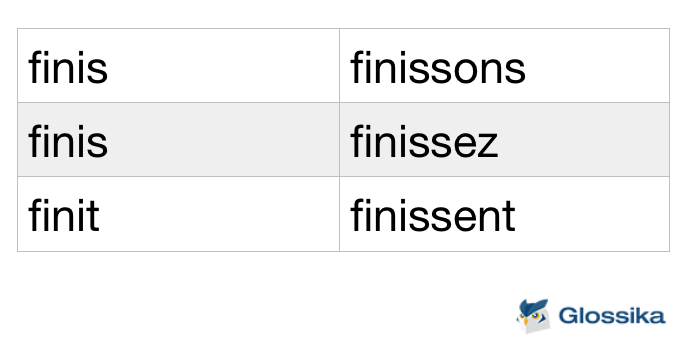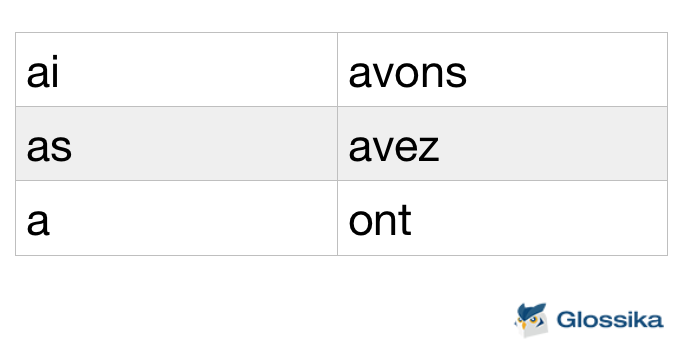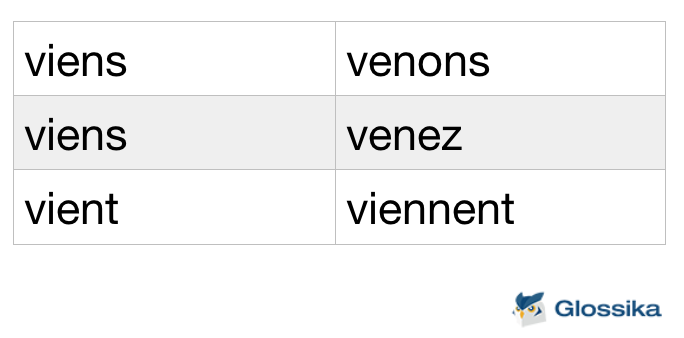What Are Conjugations? How Do You Learn French Conjugations?
Conjugations are variations on verbs in an inflected language that reflect voice, mood, tense, number, and person. Conjugations are used in languages such as French, Spanish, Latin, Greek, and Sanskrit. English also uses conjugations, but these have become simplified from earlier forms. Compare “You have a book” to “Thou hast a book”; the latter has fallen out of use. A single conjugation can give quite a lot of information about who is completing an action, when this action is completed, or the probability of this action taking place.
How Verb Conjugations in French are Formed?
Verb conjugations in French are formed with a radical and endings for simple tenses and with an auxiliary verb and a past participle for compound tenses. For the present tense, we refer to the infinitive form of a verb to which we add present tense endings. In the phrase “Quand je danse, je danse” (from Michel de Montaigne’s “De l’expérience” Essais III 13), the word “danse” is the first person singular, present active indicative form of danser, which gives information about who is dancing, when it takes place, and whether this action is more hypothetical or more concrete. It is formed by taking the -er ending off of the infinitive form, giving us the radical dans-, to which we add an -e. This form is distinct from the form found in a phrase such as “J’aimerais que vous dansiez quand la musique commence”, which reflects a request that someone complete an action, which may or may not happen. In this more complex sentence, the first verb is a first person singular present active conditional, the second verb is a second person plural present active subjunctive, and the third is a third person singular present active indicative. All of these verbs are verbs whose infinitive forms end in -er, but their radicals differ a bit, the conditional form using the entire infinitive as a radical, the subjunctive forming a radical from the third person plural present active indicative form of the verb with the -ent removed, and the present forming a radical from the infinitive form with the -er removed, as stated above.
Here is a table illustrating the formation of the conjugations used above.

We can contrast this use of conjugation with other languages for which we do not use conjugations, such as Chinese:
当 - 我 - 跳舞 - 的时侯, - 我 - 跳舞。
when - I - to dance - at that time, - I - to dance
In this Chinese translation of Montaigne’s observation about his dancing, 跳舞 designates the action of dancing and it would remain constant in a sentence describing past events, events to come, requests to dance, possibilities of dancing, and all sorts of other sentences involving dancing.
French, on the other hand, seems to have conjugations for every time frame or mood imaginable, which can seem overwhelming until we remember that the vast majority of verbs are conjugated in the manner of the verb aimer and that many conjugations sound the same. Irregularities do occur in frequently used verbs (think of the game “Telephone” and how distorted words get from being repeated so much and you get an idea of why), but since they are frequently used and used in many expressions, they become reinforced with repetition. I did have a Chinese student who said that French conjugations were more difficult than Chinese characters, but I beg to differ, as we are still only dealing with certain combinations of 26 letters which appear again and again in different tenses and modes. That’s easier than memorizing 4,000 characters, which is the number designated for a person with a good level of education in Chinese.
Learn French Conjugations in a Systematic Way
It is true that there are many conjugations in French, to go along with all of the verb tenses and moods that exist in the French language, so it is useful to approach these categorically. They are introduced in textbooks as belonging to one of three groups or else as having irregular patterns. The first group includes verbs ending in -er, with the exception of the verb aller, which is irregular, the second group includes verbs ending in -ir, and the third group includes verbs ending in -re. The patterns of irregular verbs deviate from the patterns that we see in the main groups of verbs, but within these irregularities, there are certain verbs that resemble one another and that are used in similar ways, which I will describe below.
In general, you should learn these different patterns, along with how to form the radical of verbs in the particular tense or mode you are using. Here are five different verbs from which we will derive radicals for five different tenses and modes, focusing on the third person singular conjugation for each verb, with the exception of the present participle, an impersonal mode that does not change with person or number:

Some verbs will have irregular radicals or will completely change form, as with the verbs avoir and être.
Most compound tenses will be a combination of those shown above, e.g., the pluperfect tense uses the imperfect tense with a past participle (“avait mangé”), compound present participles use a present participle with a past participle (“ayant fini”).
3 Main Groups of French Verb Conjugations
Let’s look at the present tense conjugations for the three main groups of verbs in French.
1e groupe - aimer

Around 90% of verbs follow the pattern of this first group of verbs. You will notice that four of the conjugations sound the same, which is great for speaking, but which requires more attention when writing. We call this the boot because when we highlight these four conjugations on a two-column table, they take on a shape that is vaguely similar to a boot.

2e groupe - finir

In the second group of verbs, the singular conjugations sound the same and the plural ones each sound different. Listen carefully for the final consonant sound in the third person plural form, which distinguishes it from the third person singular, e.g., finit, finissent; agit, agissent; choisit, choisissent. There is another, smaller category of verbs ending in -ir that do not have the infixe -iss and that are conjugated in this manner:
2e groupe - sortir

You can still listen for the final consonant sound to distinguish the third person singular and plural forms of the verb.
3e groupe - rendre

The third group of verbs ends in -re. You simply remove the -re of the infinitive form and add the endings shown above (for the third person singular, you add nothing). As with verbs of the second group, the singular forms sound the same while the plural forms sound different from one another and the final consonant sound of the third person plural form distinguishes it from the third person singular.
Irregular Verbs
There are irregular verbs that are frequently used, such as avoir, être, aller, and faire. These are used often, including with idiomatic expressions having to do with weather, sports, and music as well as age, hunger, thirst, heat, cold, and time expressions. Avoir and être are also used for compound verb tenses. Aller is used for the futur proche.
avoir

être

aller

faire

The verbs tenir and venir are -ir verbs with irregular conjugations that resemble each other.
tenir

venir

Notice the nasal e sound /ɛ̃/ in the singular conjugations, which we can contrast with the denasalized e /ɛ/ in the third person plural conjugation. We also have a schwa /ǝ/ as the first vowel sound in the first and second person plural conjugations.
The verb prendre is often used, in idiomatic expressions as well as for various activities, including eating, photography, and transit.
prendre

The conjugation is very similar to rendre, except for the doubled n that allows the preceding e to be open and denasalized, /ɛ/.
Other irregular verbs include verbs such as the modal verbs pouvoir, vouloir, and devoir. Their conjugations are similar and they are also often used as leading verbs with an infinitive, being related to ability, desire, and necessity.
pouvoir

vouloir

devoir

Note the contrast between the more closed /ø/ vowel sound in the singular conjugations and more open /œ/ vowel sound in the third person plural conjugation of pouvoir and vouloir. Also note the diphthong /wa/ in four “boot” conjugations of the verb devoir.
Imperatives
Imperative modes are used with second person singular and plural subjects and with a first person plural subject. Used for commands – or for suggestions in the case of the first person plural – they are not needed for other conjugations, which do not address another person directly. Conjugations usually correspond to the indicative forms of these verbs, and may have irregularities or slight spelling changes, such as the dropped e in -er verbs. Some examples of phrases with imperative conjugations include: “Parle plus fort”, “Finis tes devoirs”, “Choisissons notre gâteau”, “Sortez!”, and “Veuillez vous éloigner”. The imperative forms of avoir and être resemble subjunctive forms, e.g. “N’aie pas peur”, “Soyez calme”.
Phonetic Consistency and Spelling Changes
Some irregularities in verbs are related to spelling changes, which generally help to preserve the pronunciation, so these spelling changes are actually helpful phonetically. One example is the -er verb commencer,whose first person plural form has a cédille added to the c in order to preserve the soft /s/ sound, i.e., commençons. Otherwise the pronunciation of the c would become a /k/ sound and it would be inconsistent with the rest of the conjugation.
Other verbs that have spelling changes involving accent marks include préférer, since we cannot have a lone e preceding a consonant followed by an e – or phonetic equivalent – unless there is an accent grave over it, as with préfère, préfères, préfèrent.
An alternate “solution” to this phonetic issue is to double the final pronounced consonant, as with the verb jeter, e.g., “je jette”. You will have to memorize when this occurs as opposed to placing an accent grave over the penultimate e, as with the verb geler, e.g. “il gèle”.
Recommended Learning Resources
French schoolchildren use the Bescherelle conjugation manual as a reference for conjugations and it is a good reference for everyone. The Bescherelle also has a website with activities and exercises, such as the very French dictée in which you write down sentences that you listen to, taking care to write the proper verb forms for all of those conjugations that sound the same!

Combining audio and writing skills is a good way to practice your French conjugations so that you will use them with ease. Besides Bescherelle, you can also use Glossika to practice your French. Glossika is a language learning platform that sorts natural languages by structure and difficulty, delivering memory, pronunciation and fluency skills to language learners between any two languages.
They have more than 7000 French sentences ranging from A1 to C1.

In addition to Bescherelle and Glossika, French magazines and newspapers, such as Le Nouvel Observateur and Le Monde also have online resources for conjugations of verbs.
PS. The number of French conjugations may be quite copious, but I still maintain that learning them is not nearly as difficult as learning Chinese characters. What do members of the waitstaff of restaurants in the Shaanxi province of China do when people order this well-known noodle dish?

You May Also Like:
- Do You Really Need to Know the Passé Simple in French?
- The Ultimate Guide to French Tenses
- How to Use These 4 Common Verbs in French
- Follow us on Instagram:



